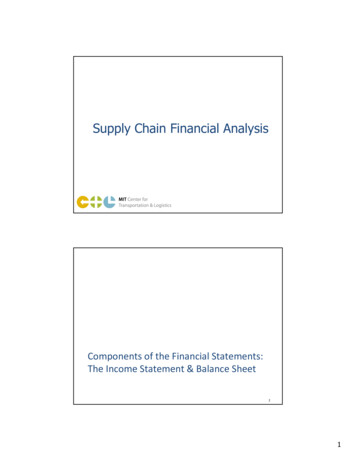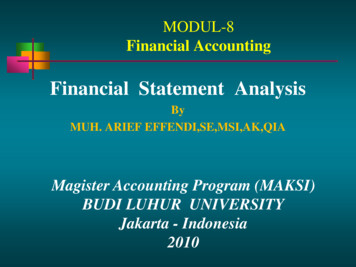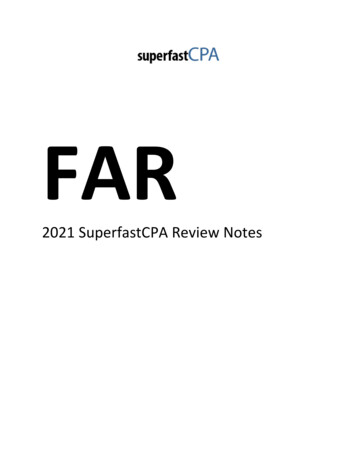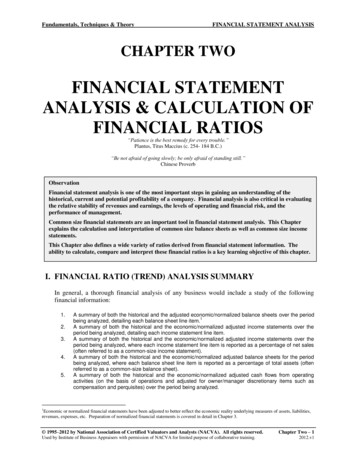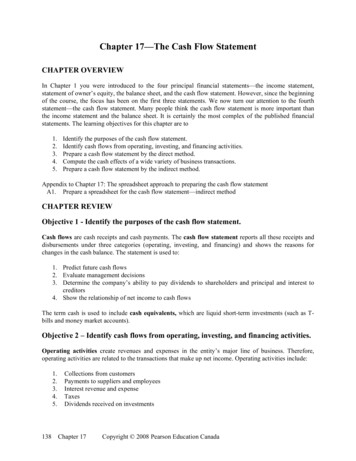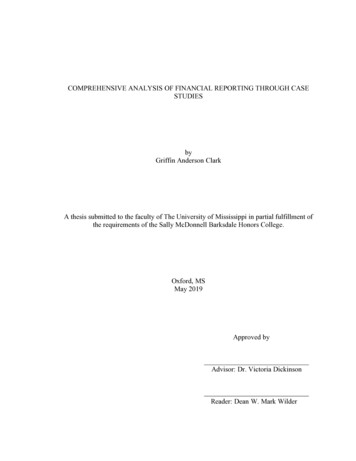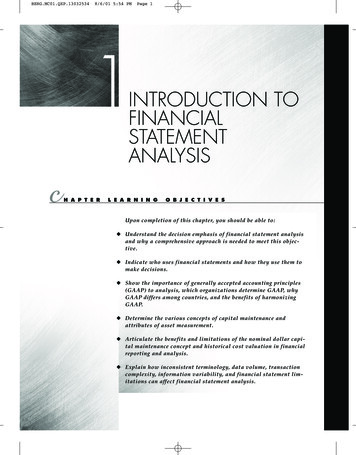
Transcription
BERG.MC01.QXP.130325348/6/01 5:54 PMPage 11INTRODUCTION TOFINANCIALSTATEMENTANALYSISH A P T E RL E A R N I N GO B J E C T I V E SUpon completion of this chapter, you should be able to: Understand the decision emphasis of financial statement analysisand why a comprehensive approach is needed to meet this objective. Indicate who uses financial statements and how they use them tomake decisions. Show the importance of generally accepted accounting principles(GAAP) to analysis, which organizations determine GAAP, whyGAAP differs among countries, and the benefits of harmonizingGAAP. Determine the various concepts of capital maintenance andattributes of asset measurement. Articulate the benefits and limitations of the nominal dollar capital maintenance concept and historical cost valuation in financialreporting and analysis. Explain how inconsistent terminology, data volume, transactioncomplexity, information variability, and financial statement limitations can affect financial statement analysis.
BERG.MC01.QXP.130325348/6/01 5:54 PMPage 2nalysts separate something whole—an engine, a manufacturing process, afootball team, a presidential election, or a financial statement—into itsparts. They then examine the elements to find out their nature, proportion, function, and interrelationship. The analytical method provides insights about howthe entirety operates, where it came from, and where it is going.Financial statement analysis is the art and science of examining the components of a company’s monetary disclosures, called financial statements. Peopleform opinions about a firm’s past, present, and future operations based on theiranalysis. These beliefs guide their own actions and influence others who rely ontheir recommendations. Decisions result: choices people make in allocating theirfinancial resources.OBJECTIVEThe objective of this book is to help you learn how to analyze financial statements.1 It aims to help you develop your ability to critically evaluate corporatefinancial representations and related information. Chapter 1 begins this processby addressing four factors: The chapter begins by presenting the requirements fora comprehensive analysis. Next, we turn to analysts’ objectives. The third sectioncovers the standards that govern financial disclosures, and finally, we address disclosure challenges.COMPREHENSIVE ANALYSISFinancial statements communicate a firm’s economic events to interested readers.They do so in aggregate form by summarizing an entity’s dealings with people,organizations, processes, and things. In order to analyze this highly abstracted setof data, the analyst must understand the influences on financial statements andhow to obtain information about those factors.BUSINESS ENVIRONMENTWEBXERCISE 1Go online to www.Apple.comand examine Apple Computer,Inc.’s financial statements. Clickon “Hot News,” locate “AboutApple,” and click on “InvestorInformation.” Search “SECFilings” for “Form10-K” andscroll through the most recentyear’s Form 10-K until youlocate “Item 8, FinancialStatements and SupplementaryData.” Examine its contents.2Analysts must understand the overall economy, legal environment, political climate, and cultural context in which a company does business. They also have toconsider a company’s industry and its competition when judging financial performance. Such insights require knowledge of business strategies, managerialpolicies, information systems, productive capabilities, labor relations, distribution networks, and marketing channels, even though many of these factorsexceed the scope of the financial statements. Analysts must answer such questions as these:1This book views financial statement analysis from a broad perspective. Anyone who uses financialstatement data to make decisions is considered a financial analyst or financial statement analyst for thepurposes of this text. In a narrower sense, a financial analyst is an individual with expertise in evaluating financial investments with an emphasis on determining the risk and reward characteristics of stocksand bonds. See, for example, D. L. Scott, Wall Street Words (Boston: Houghton Mifflin, 1997), p. 145.F I N A N C I A LS T A T E M E N TA N A L Y S I S
BERG.MC01.QXP.130325348/6/01 5:55 PMWEBXERCISE 2Explore hoovers.com, zacks.com,and thomsoninvest.net for examples of Internet sites that canassist in your analysis.Page 3 How sensitive are the company’s activities to changes in economic conditions? Are there any legislative or regulatory initiatives pending that will affectbusiness? Is the industry in which the company competes emerging, growing, or mature? Who are the firm’s key competitors? Are management and the workforce well trained? Is the company planning any product introductions or market penetrations?These questions cannot be answered by directly examining a company’s financialstatements; yet, such events have influenced previous corporate disclosures andaffect their forecasts. Therefore, the analyst needs to develop a comprehensiveperspective when analyzing financial statements, or risk making poor judgmentsand bad decisions.DATA SOURCESWEBXERCISE 3Examine “Item 7, Management’sDiscussion and Analysis ofFinancial Conditions andResults of Operations” for AppleComputer’s most recent Form10-K to read about management’s thoughts on Apple’sfuture.A broad-based approach to financial statement analysis requires a breadth ofinformation. The analyst must locate and use a variety of current and historicaldata sources to supplement the financial data supplied by the company. Suppose,for example, you wanted to forecast earnings. Corporate income numbers are disclosed in the financial statements, so you might start with these data to constructan earnings trend line. Previous trends, however, do not guarantee future results.Economic conditions, market shifts, competitor initiatives, and managerial decisions also affect future earnings. You must consider these factors, and others likethem, in a comprehensive earnings forecast.Data come in many forms, are found in many places, contain various benefits,and have different costs. Moreover, information is fluid. One need only look to theInternet for evidence of the changing information landscape. Information caneither be primarily numerical or verbal; it also contains various degrees of objectivity and subjectivity. Market share data gathered by an independent party, forexample, are more reliable than those presented by someone with a vested interestin the company. Management’s interpretation of those numbers is more subjectiveand qualitative than the market share data themselves. Analysts can find value inall of these information sources, provided they adjust for existing biases.ANALYSTS’ ETHICSWHAT'S YOUR ANALYSISC H A P T E R1 :Financial analysts often release research reports, which provide potential investorswith the analyst’s opinion about a company. Relatively unknown firms crave researchrepor ts because they seek publicity. Other companies oppose these opinions; theirmanagers fear that analysts may cast them in a negative light. Consider the ethicalimplications in the contrasting cases of Telesoft Corp. and First Union Bank.Telesoft Corp. is a small telecommunications firm based in Phoenix, Arizona. It isnot well known to investors. ComVest of fered to provide a research repor t onTelesoft in exchange for ownership considerations. a The Dallas, Texas, securities firmspeculated that its research repor t would add 15 per share to Telesoft’s current 5market price. In exchange for providing such a research report, ComVest proposedreceiving stock warrants in Telesoft, which would enable the securities firm to purchase 100,000 shares of the company’s common stock at 5.50 per share. TelesoftI N T R O D U C T I O NT OF I N A N C I A LS T A T E M E N TA N A L Y S I S3
BERG.MC01.QXP.130325348/6/01 5:55 PMPage 4declined the offer. “Exchanging warrants for research was unequivocally the wrongway to go,” according to Michael Zerbib, chief financial officer of Telesoft. bA financial analyst’s research repor ts af fected First Union Bank of Charlotte,Nor th Carolina, differently. First Union used the ser vices of the investment-bankingfir m Bear Stearns to raise capital in the long-term debt market. The Wall Streetinvestment bank earned over 10 million annually for its ser vices to the Nor thCarolina regional bank. Then a prominent analyst at Bear Stearns issued a criticalassessment of First Union’s operations and management. First Union responded byremoving its bond-trading business from Bear Stear ns, allegedly, because of thenegative repor t. cIn Telesoft’s case, the company lacked a credible favorable financial analysis;conversely, First Union was saddled with a negative one. ComVest proposed a financial analysis to solve Telesoft’s dilemma, but Bear Stearns may have lost businessdue to its financial analysis of First Union.ObservationsAs someone interested in financial analysis, how would you evaluate the ethicalbehavior of the par ties involved in each of the two cases?C. Gaprarino, “Starved for Attention, Small Companies ‘Buy’ Wall Street Coverage,” Wall Street Journal, July14, 1999, pp. A1 and A10.Ibid, p. A10.cR. Brooks, “Analyst’s Silence on First Union Isn’t Accidental,” Wall Street Journal, August 17, 1999, pp. C1and C4.abANALYSTS’ OBJECTIVESPeople analyze corporate financial statements for various reasons. Seven groupsof financial statement users exist: equity investors, credit granters, corporate managers, merger and acquisition specialists, internal and external auditors, regulators, and corporate employees. We now explore the objectives of each group.EQUITY INVESTORSMICRONALYSIS 1The Coca-Cola Co.’s mission is“To maximize share-ownerwealth over time.” This missionstatement embodies the orientation of all companies and theirowners.Equity investors are the ultimate risktakers. As business owners, their wealthincreases when a company prospers, and it shrinks when the firm falters. Theysupply the risk capital that protects other stakeholders’ investments in the firm.As such, they legally own the business, and the corporation is obligated to protecttheir interest. As shareholders, equity investors claim a residual interest in theassets of the company; they earn a return on their investment only after the otherstakeholder claims have been satisfied.Shareholders, like all people, try to improve their financial standing. They doso when corporations use their resources to the fullest extent possible in generating cash. Stock prices reflect the relative success of a company’s cash-generatingefforts.2 The objective of equity investors, therefore, is to devise investment portfo-See, for example, A. C. Shapiro and S. D. Balbirer’s discussion of wealth maximization in Chapter 5 ofModern Corporate Finance: A Multidisciplinary Approach to Value Creation (Upper Saddle River, NJ:Prentice Hall, 2000).24F I N A N C I A LS T A T E M E N TA N A L Y S I S
BERG.MC01.QXP.130325348/6/01 5:55 PMMICRONALYSIS 2Unlike a primary stock issue,companies do not receive cashinfusions from secondary markettransactions. Think of primaryand secondary investments thisway: If you purchase a new automobile from Ford Motor Co.,then the automaker receives acash infusion. Buying a usedFord from a friend, however,doesn’t directly benefit Ford. Youwant to get the maximum returnfrom your automotive investment, regardless of the source ofyour investment.MICRONALYSIS 3Warren Buffet, CEO of BerkshireHathaway, continually beats themarket. Does the “Sage ofOmaha” know something thatthe rest of investors don’t know?Page 5lios that maximize wealth, subject to an acceptable level of risk. They analyzefinancial statements to assist in that task.The market in which investors purchase new, as opposed to existing, shares ofstock are sold is called the primary market. In most instances, however, equityinvestors don’t buy stock directly from a company; they purchase shares fromother equity investors in secondary markets.3 Regardless of where they acquire ownership, equity investors analyze financial statements and related information tobuild wealth. They evaluate corporate cash-generating abilities by using currentand historical data. Equity investors seek answers to such questions as these: Will corporate actions increase the present value of future cash distributions?How much cash does the core business activity generate?What are the long-term earnings prospects of a company?Is a company financed primarily with equity investments or borrowed funds?How does a company being analyzed compare with its competitors?Equity investors are influenced by theories that developed in the last half ofthe 20th century. In the 1950s, portfolio theory provided a framework for evaluating investment risks and rewards.4 In the next decade, the capital asset pricingmodel (CAPM) extended portfolio theory.5 The CAPM quantifies the price of riskand formally specifies the relationship between risk and reward. Following this,the efficient market hypothesis states that stock prices fully reflect all publicly available information.6 According to this hypothesis, excessive rates of returns cannotbe earned through financial analysis. This might lead one to ask, “Why shouldequity investors analyze financial statements?” Equity investors do so for the following reasons: Their efforts ensure market efficiency. They realize positive, if not excessive, rates of return, because companies createwealth over time. Some of them think they can beat the market. They need to value privately held enterprises. People often pay them for their opinions.CREDIT GRANTERSCreditors analyze financial statements to assess the probability of prompt andcomplete loan repayment. They make loans for both short and long periods oftime. Short-term creditors finance current business operations. A manufacturertrading with a merchant, for example, establishes reasonable certainty of repayment before extending goods on credit to the retailer. Most vendors know theircustomers; consequently, they have little need for formal financial statementanalysis for short-term trade credit arrangements.Financial intermediaries, such as the New York Stock Exchange, facilitate these secondary or after market transactions.4See, for example, H. A. Markowitz, “Portfolio Selection,” Journal of Finance, March 1952, pp. 77–91.5One example of CAPM is W. F. Sharpe’s, “Capital Asset Prices: A Theory of Market Equilibrium underConditions of Risk,” Journal of Finance, September 1964, pp. 425–442.6A summary of this hypothesis is contained in E. F. Fama’s “Efficient Capital Markets: A Review ofTheory and Empirical Work,” Journal of Finance, May 1970, pp. 383–417.3C H A P T E R1 :I N T R O D U C T I O NT OF I N A N C I A LS T A T E M E N TA N A L Y S I S5
BERG.MC01.QXP.130325348/6/01 5:55 PMMICRONALYSIS 4AmeriServe Food DistributionInc.’s relations with its suppliersbecame so strained that vendorswould only sell to AmeriServeon a cash basis. The food distributor filed for bankruptcy shortlyafter vendors cut off their credit.Page 6Long-term creditors finance major projects, such as building construction andmachinery acquisitions. These lenders spend considerable resources analyzing anapplicant’s financial statement. Credit analysts evaluate the financial disclosuresto determine a loan applicant’s debt service capability. They investigate a numberof factors in doing so, including credit history, outstanding obligations, and cashflow projections. Lenders protect their investment by formalizing loan contracts,collateralizing them, and establishing protective covenants.7Capital structure, the relative proportion of an entity’s liabilities and equity,influences lending decisions. Analysts attempt to determine whether additionaldebt will enable an entity to leverage borrowed funds into incremental cash flowsor prove too great of a drain on corporate resources. Equity financing, therefore,represents a margin of safety to creditors. A credit analyst judges the adequacy ofa company’s safety margin before lending it money.CORPORATE MANAGERSWEBXERCISE 4Examine Apple Computer’sstock price history, available atApple.com. Have investors’ perceptions of Apple’s valuechanged over time?Managers are business professionals who operate the firm for the owners’ benefit.As corporate employees, their duty is to maximize corporate share price throughthe productive and prudent use of the entity’s assets. Managers seek to add valueto the enterprise through their efforts. Inefficient management creates a value gap,or the difference between the firm’s worth if it were optimally managed and itsactual value.Managers use financial statement information to control and plan corporateactivities. These disclosures help them formulate business strategies, productofferings, and marketing initiatives. Operating executives monitor resource utilization and seek ways to improve it using financial statement data. Corporatedata also help managers identify, explain, and remedy differences between financial performance and budgeted expectations.A potential problem exists because managers control the flow of a firm’sfinancial information. They are charged with supplying relevant and reliablefinancial information to corporate outsiders, but as insiders, they have greateraccess to information. However, managers should not capitalize on their inherentinformation advantage. They have a fiduciary duty, or an obligation to protectequity investors’ interests, in running the firm. Like shareholders (and most people, for that matter), managers want to maximize their wealth. Investors and managers contract to protect their respective self-interests. Financial statements canassist in these contracting arrangements.8MERGERS AND ACQUISITION SPECIALISTSMerger and acquisition (M&A) specialists attempt to increase shareholder valuethrough corporate realignment. They benefit from the fees they receive for theirservices. These specialists continually search for undervalued companies—firmswhose true worth exceeds their market price. In other words, they try to findCovenants protect the lender’s claim by mandating that the borrower’s financial position remain inapproximately the same conditions that existed at the inception of the loan.8The study of the field of contracting agreements between owners and managers is known as agencytheory. For a discussion of this theory see H. I. Wolk and M. G. Tearney, Accounting Theory: A Conceptualand Institutional Approach, 4th Ed. (Cincinnati: South-Western, 1997), pp. 42–44.76F I N A N C I A LS T A T E M E N TA N A L Y S I S
BERG.MC01.QXP.130325348/6/01 5:55 PMMICRONALYSIS 5The Securities and ExchangeCommission reported 847 billion of business consolidations inthe first half of 2000.Page 7value gaps in one or both parties to a prospective business consolidation. A successful merger or acquisition decreases gaps in value and helps maximize shareholder wealth. Financial statement analysis assists these analysts in determiningwhether the companies are worth combining. Data analysis, for instance, couldreveal operating inefficiencies, product duplications, or overlapping markets. Abusiness combination could reduce costs or increase revenues, thereby unlockingshareholder value.Merger and acquisition specialists often make numerous adjustments to thefinancial statements when valuing a firm. They make these corrections to betteraccount for market value; again, this indicates the limitations inherent in financialstatement disclosures and the need for supplementary information. As other typesof financial analysts do, M&A specialists seek the most relevant information possible when deciding whether to combine separate entities.INTERNAL AND EXTERNAL AUDITORSMICRONALYSIS 6Cendant Corp. lost 14 billionfrom its market share when massive financial fraud was discovered. Investors sued the managers who perpetrated the fraudand the certified public accountant who gave the company aclean audit opinion.Internal auditors assess corporate operations, and external ones render an opinionabout the accuracy of an entity’s financial statements. Auditors employed by anentity ensure compliance with corporate policies, measure performance, and recommend operating improvements. Independent certified public accountantsexpress an opinion about the fairness of a company’s financial statements. Bothauditing groups analyze financial statements in performing their jobs. For example, internal auditors use financial statement ratios to measure asset utilization.External auditors document those assets’ existence and confirm their ownershipin attesting to the accuracy of management’s assertions about them.Not only do auditors evaluate financial statements in doing their jobs, buttheir opinions also influence other analysts’ judgments. Managers base manydecisions on internal audit reports, and external stakeholders rely on independentaudit opinions. Poor audits can cause incorrect and costly decisions. Consider acompany that appears profitable, according to its financial statements, and assuch, it continually receives clean audit opinions. The glowing financial statements, however, resulted from fraudulent financial reporting, and the audit failedto detect the deceit. In reality, the company is bankrupt! Precious resources couldbe squandered on a nonproductive enterprise.REGULATORSMICRONALYSIS 7Major narcotics dealers are routinely prosecuted for financialcrimes, such as tax evasion andmoney laundering, as well asnarcotics violations.C H A P T E R1 :Many government agencies analyze financial statements as part of their regulatory duties. The Securities and Exchange Commission (SEC), for example,administers U.S. securities laws. The commission’s charge is to ensure thatinvestors and creditors receive full and fair disclosure about corporate activities.Corporations file many forms with the SEC to that end, and commission analystsmonitor the extent to which entities comply with securities laws.The Internal Revenue Service (IRS) also uses financial information. Thisagency’s analysts judge taxpayer compliance with the Internal Revenue Code. Forexample, the IRS’s net worth analysis determines if a taxpayer’s standard of livingcoincides with his or her reported net worth, as determined by an assessment ofan individual’s financial statements.Government analysts help regulate specific industries. Bank regulators, forexample, rely on financial statement information to ensure that financial institutions are adequately funded and customers’ investments are protected. AnalystsI N T R O D U C T I O NT OF I N A N C I A LS T A T E M E N TA N A L Y S I S7
BERG.MC01.QXP.130325348/6/01 5:55 PMPage 8work for such agencies as the Federal Reserve System, the Office of theComptroller of the Currency, and state banking commissions. Government analysts also help regulate other industries, such as insurance, communication, andtransportation.CORPORATE EMPLOYEESMICRONALYSIS 8General Electric Co.’s Americanlabor unions consist of 34,000workers or 10 percent of itsglobal labor force. The terms ofthe contracts these unions negotiated with the company in 2000,however, were extended to theother 163,000 Americannonunion General Electricemployees.Employees analyze corporate disclosures to improve their bargaining positionwith management. Workers seek wage and benefit adjustments, often on the basisof financial data, when negotiating a contract. A labor union, for example, couldcite record earnings, large management bonuses, and higher compensation packages at similar firms to justify salary demands. Financial disclosures that measureworker productivity, such as the amount of operating cash flow generated peremployee, are also bargaining tools. Negotiating is a two-way street, however.Companies also use financial disclosures to buttress their position in contractingwith employees.As with the other categories of financial statement users, employee analystsbenefit from accurate and timely representations of corporate performance.Although the specific content and procedures differ among analysts, they all usepublicly disclosed data in order to make better decisions. Presenting a true andfair picture of corporate performance is the goal of financial reporting; makingsense of those disclosures is the job of financial analysts.REPORTING STANDARDSAuthoritative pronouncements and accepted conventions influence financialstatement disclosures. Analysts must understand these generally acceptedaccounting principles (GAAP) in order to interpret financial statements. Thesestandards provide a common ground for analysis. We discuss the key aspects forsetting these standards in the following sections.9A COLLABORATIVE PARTNERSHIPWEBXERCISE 5Go to www.sec.gov to find outabout the SEC and towww.fasb.org to learn about theFASB.Financial statement principles provide a basis for measuring, valuing, and comparing economic activity. These standards ensure consistent disclosure over timeand permit meaningful comparisons among companies. Commercial, economic,legal, cultural, social, political, and educational factors have all influenced theirdevelopment. Some principles have haphazardly evolved; others were deliberately created. Moreover, reporting principles change over time, as business practices and the user needs shift. Analysts need to remember that financial reportingstandards are human contrivances, not immutable laws of nature!A working relationship between the public and private sectors determinesthe authoritative standards that constitute GAAP. The federal government’s SEChas legal authority to set accounting standards, but it has generally ceded thattask to a private organization, the Financial Accounting Standards Board9This section of Chapter 1 discusses financial reporting orientation and the rule-making process.Chapters 6 and 7 address specific accounting principles.8F I N A N C I A LS T A T E M E N TA N A L Y S I S
BERG.MC01.QXP.130325348/6/01 5:55 PMMICRONALYSIS 9High-tech firms opposed FASB’sproposed revisions for reportingbusiness consolidations becausethey viewed the proposal asharmful to their acquisitionsstrategies.Page 9(FASB).10 The SEC reviews GAAP as part of its regulatory responsibilities. TheSEC often influences the FASB by taking a position on unresolved financialreporting issues. The collaborative effort between the SEC and FASB has produced many accounting principles that constitute the backbone of financialreporting.Reporting standards affect corporate profitability and financial position; consequently, many of the principles are quite controversial. However, despite some dissatisfaction, the public/private partnership succeeds, for the most part, in producingtimely and detailed financial reporting standards. These rules have contributed toefficient capital markets, the mechanism by which economic resources are allocated.FINANCIAL REPORTING STANDARDSThe FASB succeeded the Accounting Principles Board as the private sector rulemaker in 1973. The existing organization’s membership is more diverse than itspredecessor, which was dominated by public accountants. Businesspeople, financial executives, and educators have all served on the board. The FASB’s standardsetting authority extends to corporate financial statements, accompanying notes,and supplementary disclosures. The board establishes GAAP primarily throughits Statements of Financial Accounting Standards. It also interprets existing standards, issues technical bulletins, and addresses emerging business practices.Statements of Financial Accounting Concepts influence FASB’s standards. Thoseconceptual guideposts provide the theoretical underpinnings for its decisions.THE INTERNATIONAL DIMENSIONWEBXERCISE 6Nasdaq.com, nyse.com, andamex.com provide informationabout NASDAQ, the New YorkStock Exchange, and theAmerican Stock Exchange,respectively. Go to each Web site.Throughout the world, GAAP varies, complicating financial statement analysis.Analysts must distinguish between substantive economic differences and onesthat result merely from different disclosure methods—a challenging task.Multinational enterprises must conform to various interpretations of GAAP. Apublicly traded company reports according to the standards where its stock islisted.11 Firms traded on the New York Stock Exchange, for example, must adhereto the United States’ GAAP, regardless of where they are headquartered.In some instances, the differences in accounting treatments among nations arerather minor, but in other cases, they can be quite pronounced. Language, cultural,legal, and economic similarities account for comparable financial reporting disclosures. In the United States and the United Kingdom, for instance, GAAP are quitesimilar. And the reporting standards for many European countries are similar to oneanother but differ markedly from those of the United States and United Kingdom.For instance, German and French standards are part of the European Model offinancial reporting.12 Exhibit 1-1 differentiates the two financial reporting models.Commerce has rapidly evolved into a global marketplace, and financialreporting must keep pace with the growth of multinational enterprises. Onemeans of doing so is through the efforts of the International Accounting10Accounting Series Release No. 150 of the SEC, Statement of Policy on the Establishment and Improvementof Accounting Rules, effectively yielded financial reporting standard setting to the FASB.11In general, this statement is true, although some countries allow compliance with another nation’sGAAP or international standards.12See, for example, R.D. Nair and W. G. Frank, “The Impact of Disclosure and Measurement Practiceson International Accounting Classification,” The Accounting Review, July 1980, pp. 426–439.C H A P T E R1 :I N T R O D U C T I O NT OF I N A N C I A LS T A T E M E N TA N A L Y S I S9
BERG.MC
a C. Gaprarino, “Starved for Attention, Small Companies ‘Buy’ Wall Street Coverage,” Wall Street Journal, July 14, 1999, pp. A1 and A10. b Ibid, p. A10. c R. Brooks, “Analyst’s Silence on First Union Isn’t Accidental,” Wall Street Journal,August 17, 1999, pp. C1 and C4. Peop


